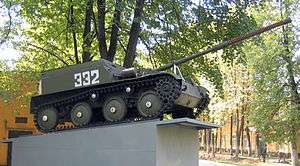ASU-57
| ASU-57 | |
|---|---|
 | |
| Type | Airborne Tank Destroyer / Assault Gun |
| Place of origin | USSR |
| Service history | |
| In service | 1951- late 1960s (USSR) |
| Used by |
USSR Egypt Vietnam Yugoslavia Ethiopia |
| Wars |
Six Day War Ogaden War |
| Production history | |
| Designer | Astrov Design Bureau |
| Manufacturer | MMZ |
| Produced | 1950-1962 |
| Specifications | |
| Weight | 3.4 tonnes |
| Length |
3.48 m (11 ft 5 in) (hull) |
| Width | 2.08 m (6 ft 10 in) |
| Height |
1.18 m (3 ft 10 in) (shield up) |
| Crew | 3+6 |
|
| |
| Armor | 6 mm |
Main armament | 1x Ch-51 or Ch-51M L/73 57mm Gun |
Secondary armament | 1x 7.62mm anti-aircraft machine gun |
| Engine |
one M-20E4 water cooled gasoline engine 50hp (37.29 kW) (55hp with later engine) |
| Suspension | torsion bar |
| Fuel capacity | 140 liters (37 gallons) |
Operational range | 250 km (160 mi) |
| Speed | 45 km/h (28 mph) |
The ASU-57 was a small, lightly constructed Soviet assault gun specifically designed for use by Soviet airborne divisions. From 1960 onwards, it was gradually phased out in favour of the ASU-85.
Development history
The task to develop a light-weight assault gun for the airborne troops (with either a 57mm gun or a 76mm gun) was given to two design bureaus, Astrov (OKB-40) in Mytishchi and Kravtsev in Moscow. Nikolaj Astrov's OKB-40 designed the ASU-76, based on components of the T-70 light tank and the SU-76 assault gun, and armed with the new 76mm gun D-56T. The ASU-76 turned out to be too heavy, even though the armour was only 3 mm thick, and the project was cancelled. Anatoly Kravtsev's team came up with the similar, amphibious K-73. This vehicle was armed with Charnko's 57mm anti-tank gun Ch-51 and was even more thinly armoured than the ASU-76. This project too was shelved.
In 1949, Astrov was instructed to continue with his project, but with reduced weight and with the Ch-51 gun as the main armament instead of the D-56T, since it offered better anti-tank performance. The redesigned Ob.572 was developed simultaneously with the Ob.561 (AT-P) light artillery tractor. After successfully passing the various test phases in 1949, it was accepted for series production from 1951 as the ASU-57.
Design

The ASU-57 was designed to be a light-weight assault gun that could be air-dropped and deployed by rocket-assisted parachute (PP-128-500 or P-7) along with the troops. It was lightly armored and armed with a 57 mm gun Ch-51, a development of the World War II ZIS-2 but with some similarities to the Ch-26. From 1954, an improved 57mm gun Ch-51M with a much shorter double-baffle muzzle brake was fitted. The gun fired the standard caliber 57x480R ammunition of the ZIS-2 anti-tank gun, such as the BR-271 series and the O-271U, of which it had 30 on board. The ASU-57's engine was taken from the GAZ-M-20 "Pobeda" civilian car.
The ASU-57 was a successful design that saw service with Soviet airborne divisions for around 20 years before being replaced by the ASU-85. During its years of operation, 54 vehicles would have been assigned to each airborne division.
One main drawback was the vehicle's welded aluminum hull, which offered little protection for the crew. However, for airborne troops, such vehicles are invaluable, giving lightly armed soldiers who are isolated behind enemy lines mobile artillery support on the battlefield.
Every vehicle was equipped with a 10RT-12 radio and a TPU-47 intercom system. Late-production models (from 1961) replaced these with the R-113 and R-120 respectively, and also had a TVN-2 night vision device for the driver.
Variants

- ASU-57KShM - An unknown number of ASU-57s were converted into command and staff vehicles (Russian: командно-штабная машина). These had the gun removed and were fitted with additional signals equipment.
- BSU-11-57F or 2T2 - Recoilless gun carrier for the B-11 of 107mm. Prototype only.
- ASU-57P or Ob.574 - From 1951, work on an amphibious (Russian: плавающая) variant of the ASU-57 started. This version had a re-designed front hull and was armed with a Ch-51P gun with 30 rounds. Even though the five prototypes passed the evaluation with success, series production was never started.
Operators

Former operators
- Egyptian Army received a small number of ASU-57s in early 1960s; they were used during Six Day War in 1967.
- Ethiopian Army received a few dozen SPGs during the Ogaden War in 1977.
- Nationale Volksarmee received 20 former Soviet Army vehicles in 1961-62.
- Korean People's Army Ground Force ordered 200 vehicles in 1966. All were previously used by the Soviet Army and were delivered in 1967 and 1968
- Ludowe Wojsko Polskie received 100 brand new ASU-57s in 1962.
- Polisario Front received an unknown number of vehicles from Libya.
- Soviet Army operated ASU-57s in the airborne divisions of the Soviet Airborne Forces.
References
- Koll, Christian (2009). Soviet Cannon - A Comprehensive Study of Soviet Arms and Ammunition in Calibres 12.7mm to 57mm. Austria: Koll. p. 491. ISBN 978-3-200-01445-9.
- Zaloga Steven J.; Hull Andrew J.; Markov David R. (1999). Soviet/Russian Armor and Artillery Design Practices: 1945 to Present. Darlington Productions. pp. 288–291. ISBN 1-892848-01-5.
- Solyankin, A.G.; Zheltov, I.G.; Kudryashov, K.N. (2010). Otechestvenniye Bronirovanniye Mashiny - XX Vek, Tom 3: 1946-1965. OOO "Tsejkhgauz". pp. 530–533. ISBN 978-5-9771-0106-6.
External links
| Wikimedia Commons has media related to ASU-57. |
- Sword of the Motherland Foundation
- Walkaround of ASU-57 presented in the Central Museum of Armed Forces (Moscow)
- Walkaround of 2T2 presented in Il'inskoye (Moscow)
- Walkaround of APNP-1 presented in Il'inskoye (Moscow)
- Poster
- https://web.archive.org/web/20110813223045/http://modelingmadness.com/reviews/misc/vehicles/stewartasu57.htm
- K-73 in Kubinka
- ASU-57P prototype during IDELF-2008